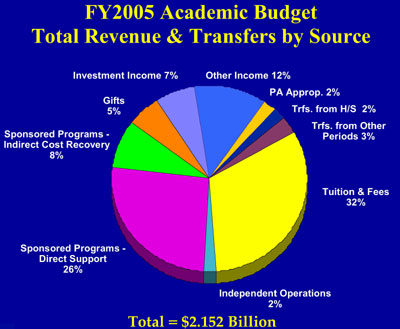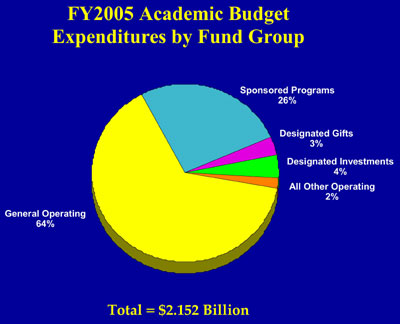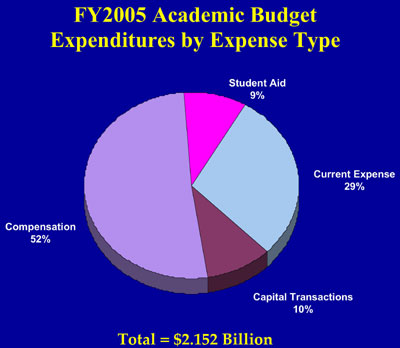
|
Fiscal Year 2005 Budget: Report to University CouncilThe annual reports by the president, provost and other administrators on the budget and other plans for the coming year were presented to University Council on March 16. President Amy Gutmann mentioned that in Penn’s efforts to help rebuild education in the tsunami-affected region, the University will collaborate with four aid agencies: Ashoka, International Rescue Committee, Operation USA and UNICEF (see www.upenn.edu/pennnews/tsunami.php). Bonnie Gibson, vice president for budget and management analysis, presented the fiscal year 2005 budget, including the key points and strategic decisions noted below as well as the consolidated expenditure budget which totals $4.181 billion. The majority of Ms. Gibson’s presentation focused on the academic portion of the budget for this fiscal year which totals $2.152 billion. The following text, bar graphs and pie charts are reprinted from her presentation.
FY2005 Budget Key Points• Total University revenue budget of $4.254 billion • Total University expenditure budget of $4.181 billion • Academic Budget of $2.152 billion* • Increase in undergraduate charges 4.8% increase in Tuition & Fees 3.2% increase in Residence Fees and Dining Fees 4.4% increase in Total Charges, versus 4.8% in FY2004 • 6.6% increase in Penn’s Undergraduate financial aid funded by General Operating Funds • University negotiating new ICR rate • Spending rule generating a decrease in expendable investment income (-2.2%) • Proposed Commonwealth appropriation is $750,000 (+1.7%) above FY2004 authorized amount (approved was $326,000 higher than proposed) • Employee Benefit Rate increasing from 30.2% to 31.2% due to double-digit increases in health care costs (excludes the 1.8% dependent tuition charge) • Allocated Cost charges increasing by 5.2%. Higher growth than previous years needed to fund new campaign and escalation in utility rates *“Academic Budget” equals total University operating budget excluding Health System FY2005 Budget Strategic Decisions• Slowed the growth in compensation by reducing the salary pool, eliminating bonuses (while retaining formal incentive plans), and restricting reclassifications and salary adjustments. • Responded to increasing utility costs by separating utilities from the standard Operations and Maintenance allocated cost charge, increasing the utilities charge by 7.5%, and creating a reserve pool to smooth fluctuations in pricing. • Invested in the campaign by ramping up staffing and programming, and by moving the advancement system forward. • Invested in the College House System by increasing funding for maintenance and programming. • Invested in critical capital projects including:
FY2005 Financial Aid Budget($Millions)
* Included in the Compensation budget line
FY2005 UG Financial Aid Budget
|
FY2003 Actual |
FY2004 Projection |
FY2005 Budget |
% Change 05B v 04P |
|
Endowment & Gift Income |
$12.0 |
$12.1 |
$12.4 |
2.5% |
Grant Income |
7.0 |
7.6 |
7.2 |
-5.3% |
General Operating Funds |
53.6 |
60.9 |
64.9 |
6.6% |
Total UG Aid Budget Aid |
$72.6 |
$80.6 |
$84.5 |
4.8% |
Note: Over the past six years, Endowment has been the fastest growing component.
Grant Income does not include work study.

Summary
• The Strategic Plan and Budget are aligned
– The President and Provost direct resources to our strategic priorities.
– Deans and senior administrators develop budgets that support the underlying strategic plans.
• Our Immediate Challenges
– Sponsored Program Direct and Indirect revenue growth is slowing.
– Financial Aid continues to grow faster than the rate of increase in tuition, driven by greater need and more generous packages for undergraduates, and by higher stipends and health insurance for graduate students.
– Financial Aid is under-endowed requiring us to use unrestricted funds to meet financial need.
• Our Long Term Opportunities
– The strategic plan has identified term and financial aid endowment, faculty chair endowment, and investments in new and renovated academic buildings as top priorities.
• Our performance through the first half of the year is strong
Interim Provost Peter Conn then introduced Dr. Philip Nichols, faculty director of the College Houses, who gave a presentation on the College Houses. Dr. Conn saluted Dr. Nichols and the College House staff for “enriching the lives of the students.” Next week’s issue of Almanac will include highlights from Dr. Nichols’ presentation as well as coverage of the remainder of the March Council meeting.
There was also a discussion of issues raised by the Report of the Committee on Pluralism concerning the United States Cultural Analysis Requirement (USCAR), followed by a discussion of issues raised by the Report of the Committee on Community Relations (Almanac March 15, 2005). President Gutmann applauded these discussions and noted that Penn cares about education—not only in the classroom but in the diverse environment. Penn has a higher percentage and a higher number of lower income students than its Ivy League peers.





